 |

Money
& Banking MGT411
VU
Lesson
18
THE
LIQUIDITY PREMIUM
THEORY
Bonds
Liquidity
Premium Theory
Stocks
Essential
Characteristics
Process
Measuring
Level of a Stock
Market
Valuing
Stocks
The
Liquidity Premium
Theory
Risk
is the key to understanding the slope of the
yield curve
The
yield curve's upward slope is due to
long-term bonds being
riskier than
short-term
bonds
Bondholders
face both inflation and interest-rate.
The longer the term the greater
the
inflation
and interest-rate risk
Inflation
risk increases over time
because investors, who care
about the real return,
must
forecast
inflation over longer
periods.
Interest-rate
risk arises when an
investor's horizon and the bond's
maturity do not match.
If
holders
of long-term bonds need to
sell them before maturity and interest
rates have
increased,
the bonds will lose
value
Including
risk in the model means that
we can think of yield as
having two parts:
Risk-free
and
Risk
premium
i1t +
i1et
+1 +
i1et
+
2
+
....
+
i1et
+
n
-1
int =
rp
n +
n
Pure
expectations theory
Risk
premium
Figure:
Relationship between the Liquidity
Premium and Expectations
Theories
Liquidity
Premium Theory Yield
curve
Liquidity
premium
Expectations
Theory Yield curve
(If
short term interest rates
are expected to
remain
constant)
Time
to maturity
59

Money
& Banking MGT411
VU
Again,
we arrive at the same three conclusions
about the term structure of interest
rates
Interest
rates of different maturities
tend to move
together.
Yields
on short-term bonds are more volatile
than those on long-term
bonds.
Long-term
yields tend to be higher
than short-term yields
Stocks:
An Introduction
Stocks
provide a key instrument for
holding personal wealth as well as a
way to diversify,
spreading
and reducing the risks that we
face
For
companies, they are one of several ways
to obtain financing.
Additionally,
Stocks
and stock markets are one of
the central links between the financial
world and the real
economy.
Stock
prices are fundamental to the
functioning of a market-based
economy
They
indicate the value of the companies
that issued the stocks
and,
They
allocate scarce investment
resources
The
firms deemed most valuable
in the marketplace for stocks are the
ones that will be able
to
obtain
financing for growth. When
resources flow to their most
valued uses, the economy
operates
more efficiently
Most
people see stock market as a place where
fortunes are easily made or
lost, and they
recoil
at
its unfathomable booms and
busts.
Great
American Depression (1929)
Post-September
11, 2001 scenario
Pakistan
stock market on roller-coaster-ride
(March 2005)
What
happens in reality?
Stock
prices tend to rise steadily and
slowly, and
Collapse
rarely when normal market
mechanisms are out of
alignment
For
most people the experience of losing or
gaining wealth suddenly is more memorable
than
the
experience of making it gradually.
By
being preoccupied with the potential
short-term losses associated with
crashes, we lose
sight
of
the gains we could realize if we took a
longer-term view
Essential
Characteristics of Common
Stock
Stocks,
also known as common stock or equity,
are shares in a firm's
ownership
From
their early days, stocks had
two important characteristics
that today are taken
for granted:
The
shares are issued in small
denominations and
The
shares are transferable
Until
recently, stockowners received a
certificate from the issuing
company, but now it is
a
computerized
process where the shares are registered
in the names of brokerage firms
that hold
them
on the owner's behalf
The
ownership of common stock conveys a number of
rights
A
stockholder is entitled to participate in
the shares of the enterprise, but this is
a residual claim
i.e.
meaning the leftovers after
all other creditors have been
paid.
Stockholders
also have limited
liability,
Even
if a company fails, the maximum amount
that the stockholder can
lose is the initial
investment
Stockholders
are entitled to vote at the
firm's annual meeting
including voting to elect
(or
remove)
the firm's board of directors
Following
are some salient features of
stock trading
1.
An
individual share represents
only a small fraction of the
value of the company that
issued
it
2.
A
large number of shares are
outstanding
3.
Prices
of individual shares are
low, allowing individuals to
make relatively small
investments
60

Money
& Banking MGT411
VU
4.
As
residual claimants, stockholders receive the proceeds
of a firm's activities only
after
all
other creditors have been
paid
5.
Because
of limited liability, investor's
losses cannot exceed the price
they paid for the
stock;
and
6.
Shareholders
can replace managers who are
doing a bad job
Measuring
the Level of the Stock
Market
Stocks
are one way in which we
choose to hold our wealth,
so when stock values rise we get
richer
and when they fall we get
poorer
These
changes affect our
consumption and saving patterns, causing general
economic activity to
fluctuate
We
need to understand the dynamics of the stock market,
in order to
Manage
our personal finances and
See
the connections between stock values and economic
conditions
Stock
market indexes
Designed
to give us a sense of the extent to
which stock prices are going
up or down
Tell
us both how much the value
of an average stock has changed, and
how much total
wealth
has
gone up or down
Provide
benchmarks for performance of money
managers, comparing how they
have done to the
market
as a whole
Every
major country in the world
has a stock market, and each
of these markets has an
index
For
the most part, these are
value-weighted indices
To
analyze the performance of these different
markets it is useful to look at
percentage changes,
but
percentage change isn't
everything
The
Dow Jones Industrial
Average
The
Standard & Poor's 500
Index
NASDAQ
Composite index
Financial
Times Stock Exchange 100
Index
Hang
Seng 100
Nikkei
225
KSE
100 Index
The
KSE100
It
contains a representative sample of common stock that
trade on the Karachi Stock
Exchange.
The
KSE stocks that comprise the
index have a total market
value of around Rs. 1,197
Billion
compared
to total market value of Rs.
1,365 Billion for over
679 stocks listed on the
Karachi
Stock
Exchange.
This
means that the KSE100 Index
represents 88 percent of the total market
capitalization of the
Karachi
Stock Exchange, as of February,
2004
61
Table of Contents:
- TEXT AND REFERENCE MATERIAL & FIVE PARTS OF THE FINANCIAL SYSTEM
- FIVE CORE PRINCIPLES OF MONEY AND BANKING:Time has Value
- MONEY & THE PAYMENT SYSTEM:Distinctions among Money, Wealth, and Income
- OTHER FORMS OF PAYMENTS:Electronic Funds Transfer, E-money
- FINANCIAL INTERMEDIARIES:Indirect Finance, Financial and Economic Development
- FINANCIAL INSTRUMENTS & FINANCIAL MARKETS:Primarily Stores of Value
- FINANCIAL INSTITUTIONS:The structure of the financial industry
- TIME VALUE OF MONEY:Future Value, Present Value
- APPLICATION OF PRESENT VALUE CONCEPTS:Compound Annual Rates
- BOND PRICING & RISK:Valuing the Principal Payment, Risk
- MEASURING RISK:Variance, Standard Deviation, Value at Risk, Risk Aversion
- EVALUATING RISK:Deciding if a risk is worth taking, Sources of Risk
- BONDS & BONDS PRICING:Zero-Coupon Bonds, Fixed Payment Loans
- YIELD TO MATURIRY:Current Yield, Holding Period Returns
- SHIFTS IN EQUILIBRIUM IN THE BOND MARKET & RISK
- BONDS & SOURCES OF BOND RISK:Inflation Risk, Bond Ratings
- TAX EFFECT & TERM STRUCTURE OF INTEREST RATE:Expectations Hypothesis
- THE LIQUIDITY PREMIUM THEORY:Essential Characteristics of Common Stock
- VALUING STOCKS:Fundamental Value and the Dividend-Discount Model
- RISK AND VALUE OF STOCKS:The Theory of Efficient Markets
- ROLE OF FINANCIAL INTERMEDIARIES:Pooling Savings
- ROLE OF FINANCIAL INTERMEDIARIES (CONTINUED):Providing Liquidity
- BANKING:The Balance Sheet of Commercial Banks, Assets: Uses of Funds
- BALANCE SHEET OF COMMERCIAL BANKS:Bank Capital and Profitability
- BANK RISK:Liquidity Risk, Credit Risk, Interest-Rate Risk
- INTEREST RATE RISK:Trading Risk, Other Risks, The Globalization of Banking
- NON- DEPOSITORY INSTITUTIONS:Insurance Companies, Securities Firms
- SECURITIES FIRMS (Continued):Finance Companies, Banking Crisis
- THE GOVERNMENT SAFETY NET:Supervision and Examination
- THE GOVERNMENT'S BANK:The Bankers' Bank, Low, Stable Inflation
- LOW, STABLE INFLATION:High, Stable Real Growth
- MEETING THE CHALLENGE: CREATING A SUCCESSFUL CENTRAL BANK
- THE MONETARY BASE:Changing the Size and Composition of the Balance Sheet
- DEPOSIT CREATION IN A SINGLE BANK:Types of Reserves
- MONEY MULTIPLIER:The Quantity of Money (M) Depends on
- TARGET FEDERAL FUNDS RATE AND OPEN MARKET OPERATION
- WHY DO WE CARE ABOUT MONETARY AGGREGATES?The Facts about Velocity
- THE FACTS ABOUT VELOCITY:Money Growth + Velocity Growth = Inflation + Real Growth
- THE PORTFOLIO DEMAND FOR MONEY:Output and Inflation in the Long Run
- MONEY GROWTH, INFLATION, AND AGGREGATE DEMAND
- DERIVING THE MONETARY POLICY REACTION CURVE
- THE AGGREGATE DEMAND CURVE:Shifting the Aggregate Demand Curve
- THE AGGREGATE SUPPLY CURVE:Inflation Shocks
- EQUILIBRIUM AND THE DETERMINATION OF OUTPUT AND INFLATION
- SHIFTS IN POTENTIAL OUTPUT AND REAL BUSINESS CYCLE THEORY